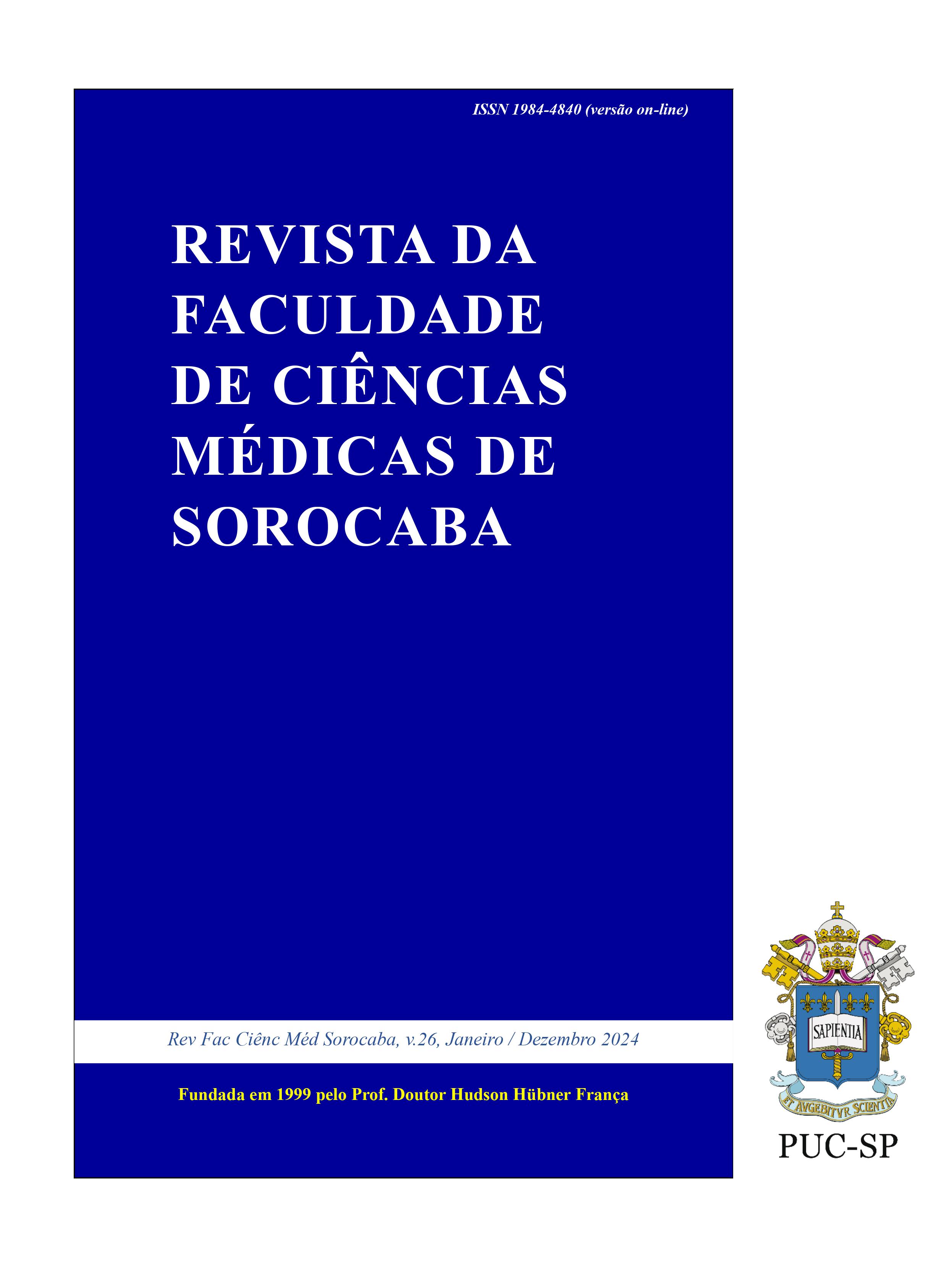Histerectomia puerperal em um hospital maternidade de alto risco na Amazônia
DOI:
https://doi.org/10.23925/1984-1840.2024v26a26Palavras-chave:
Histerectomia, Hemorragia pós-parto, Infecção puerperalResumo
Objetivo: descrever o perfil clínico e epidemiológico das pacientes submetidas à histerectomia puerperal (HP) na Fundação Santa Casa de Misericórdia do Pará (FSCMP), hospital de referência da Região Norte no atendimento materno-infantil de alta complexidade. Materiais e Métodos: foi realizado estudo observacional, retrospectivo e descritivo nos prontuários eletrônicos de pacientes submetidas à HP na FSCMP, no período de janeiro de 2020 a dezembro de 2022. Resultados: foram realizadas 94 HPs em três anos, com taxa de 3,97 HPs a cada 1.000 partos. A média de idade das pacientes foi de 30 anos. A escolaridade mais comum foi o ensino médio completo (49%), e a maioria das pacientes em estado civil de solteira (51%). Cerca de 40% delas tiveram quatro ou mais gestações, e 36% tiveram três ou mais partos anteriores. A via de parto mais frequente foi a cesariana (91%). Os principais motivos para a HP foram atonia uterina refratária e sepse de foco pélvico. Quanto à técnica operatória, a histerectomia total abdominal foi maioria (56%). Em 60% houve necessidade de transfusão de hemocomponentes e 73% dos casos exigiu assistência em UTI. A média de mortalidade foi de 3,1 óbitos para cada 100 HPs. Conclusão: a incidência de HP na FSCMP foi elevada. A maioria das pacientes eram multíparas, com um ou mais partos cesáreos anteriores, e a via de parto da gestação atual foi cesariana. Grande parte necessitou de assistência em UTI e transfusão de hemocomponentes. A mortalidade por HP na instituição da pesquisa foi menor que o ...
Referências
WHO recommendations on maternal and newborn care for a positive postnatal experience. Geneva: World Health Organization; 2022. Licence: CC BY-NC-SA 3.0 IGO.
Kwee A, Bots ML, Visser GH, Bruinse HW. Emergency peripartum hysterectomy: a prospective study in The Netherlands. Eur J Obstet Gynecol Reprod Biol. 2006;124(2):187-92. doi: 10.1016/j.ejogrb.2005.06.012.
Organização Pan-Americana da Saúde. Recomendações assistenciais para prevenção, diagnóstico e tratamento da hemorragia obstétrica. Brasília (DF): OPAS; 2018.
Machado LSM. Emergency peripartum hysterectomy: incidence, indications, risk factors and outcome. N Am J Med Sci 2011;3(8):358-61; doi: 10.4297/najms.2011.358.
Silva NA. Incidência do Near Miss Materno entre as mulheres atendidas no Sistema Público de Saúde do Brasil no ano de 2019 [monografia]. Belo Horizonte: UFMG; 2021.
R: a language and environment for statistical computing. Vienna: Team RDC; 2006. doi: 10.1007/s10985-007-9065-x[18000755].
Carvalho BAD, Ramos MET, Tenório NN, Ramos MFT, Lanza AVA, Amorim MMR, et al. Perfil sociodemográfico, epidemiológico e clínico de pacientes com hemorragia pós-parto submetidas a intervenções cirúrgicas em hospital de referência de Pernambuco [trabalho de conclusão de curso]. Recife: Faculdade Pernambucana de Saúde; 2023.
Dorigon A, Martins-Costa SH, Ramos JGL. Peripartum hysterectomies over a fifteen-year period. Rev Bras Ginecol Obstet. 2021;43(1):3–8; doi: 10.1055/s-0040-1721354.
Governo do Pará (SECOM). Santa Casa registra quase 200 altas de Covid-19 nos três primeiros meses do ano. Agência Pará [Internet]. 2021 [acesso em 20 jan. 2024]. Disponível em: https://agenciapara.com.br/noticia/27726/santa-casa-registra-quase-200-altas-de-covid-19-nos-tres-primeiros-meses-do-ano.
van den Akker T, Brobbel C, Dekkers OM, Bloemenkamp KWM. Prevalence, indications, risk indicators, and outcomes of emergency peripartum hysterectomy worldwide: a systematic review and meta-analysis. Obstet Gynecol. 2016;128(6):1281-94. doi: 10.1097/AOG.0000000000001736.
Reis AC, Galdino CV, Balbino CM, Silvino ZR. Planejamento Familiar: o conhecimento da mulher atendida no Sistema Único de Saúde sobre a saúde reprodutiva. Res Soc Dev. 2020;9(8):e393985459. doi: 10.33448/rsd-v9i8.5459.
Saldanha BL. Dificuldades enfrentadas por gestantes adolescentes em aderir ao pré-natal. Rev Eletrônica Acervo Saúde 2020;12(9):e4160. doi: 10.25248/reas.e4160.2020.
Braga A, Sun SY, Zaconeta ACM, Trapani Junior A, Luz AG, Osanan G, et al. Increase in cesarean sections in Brazil-a call to reflection. Rev Bras Ginecol Obstet. 2023;45:109-12. doi: 10.1055/s-0043-1768454.
Nunes JT, Cavalcanti AM, Santos BA, Ramos MMSP. Histerectomia periparto em hospital público no interior do nordeste brasileiro. Rev Fac Ciênc Méd Sorocaba. 2022;24(1/4):177-81. doi: 10.23925/1984-4840.2022v24i1/4a9.
Brasil. Ministério da Saúde. Manual de gestação de alto risco. Brasília (DF): Ministério da Saúde; 2022.
Gonçalves MVC, Fernandes MF, Nishiyama MP, Cruz PHR, Leite RC, Campos RR, et al. Endometrite puerperal e sepse: uma revisão. Rev Med Minas Gerais. 2012;22(Supl 5):S21–4.
Nieto-Calvache AJ, Aguilera LR. Simulation, a fundamental component of training to treat placenta accreta spectrum. Rev Bras Ginecol Obstet. 2022;44(12):1159-60. doi: 10.1055/s-0042-1760216.
Pavón-Gomez N, López R, Altamirano L, Cabrera SB, Rosales GP, Chamorro S, et al. Relationship between the prenatal diagnosis of placenta acreta spectrum and lower use of blood components. Rev Bras Ginecol Obstet. 2022;44(12):1090-3. doi: 10.1055/s-0042-1758712.
Mundhra R, Bahadur A, Sharma S, Gupta DK, Mahamood M M, Kumari P, et al. Emergency peripartum hysterectomy during COVID-19 pandemic. Cureus. 2021;13(12):e20524. doi: 10.7759/cureus.20524.
Coutinho CM, Georg AV, Marçal LCA, Nieto-Calvache AJ, Adu-Bredu T, D'Antonio F, et al. Placenta accreta spectrum disorders: current recommendations from the perspective of antenatal imaging. Rev Bras Ginecol Obstet. 2023;45(6):297-302. doi: 10.1055/s-0043-1770917.
Carvajal JA, Ramos I, Kusanovic JP, Escobar MF. Damage-control resuscitation in obstetrics. J Matern Fetal Neonatal Med. 2022;35(4):785-98. doi: 10.1080/14767058.2020.1730800.
Dantas T, Silva M, Giacomini G, Maglia P, Pavliuk M, Bretz PR P. Perfil epidemiológico de histerectomia puerperal em hospital secundário da grande São Paulo. Arch Health Invest [Internet]. 2013 [acesso em 20 jan. 2024];2(4-Suppl 3). Disponível em: https://www.archhealthinvestigation.com.br/ArcHI/article/view/296.
Berticelli MC, Matos FGOA, Alves DCI, Braun G, Kassim MJN. Perfil das infecções de sítio cirúrgico em ginecologia e obstetrícia em um hospital público de ensino. Res Soc Dev. 2021;10(14):e453101422241. doi: 10.33448/rsd-v10i14.22241.
Downloads
Publicado
Como Citar
Licença
Copyright (c) 2024 Revista da Faculdade de Ciências Médicas de Sorocaba

Este trabalho está licenciado sob uma licença Creative Commons Attribution-NonCommercial 4.0 International License.
Os autores no momento da submissão transferem os direitos autorais, assim, os manuscritos publicados passam a ser propriedade da revista.
O conteúdo do periódico está licenciado sob uma Licença Creative Commons 4.0, esta licença permite o livre acesso imediato ao trabalho e que qualquer usuário leia, baixe, copie, distribua, imprima, pesquise ou vincule aos textos completos dos artigos, rastreando-os para indexação, passá-los como dados para o software, ou usá-los para qualquer outra finalidade legal.

 Este obra está licenciada com uma Licença
Este obra está licenciada com uma Licença 